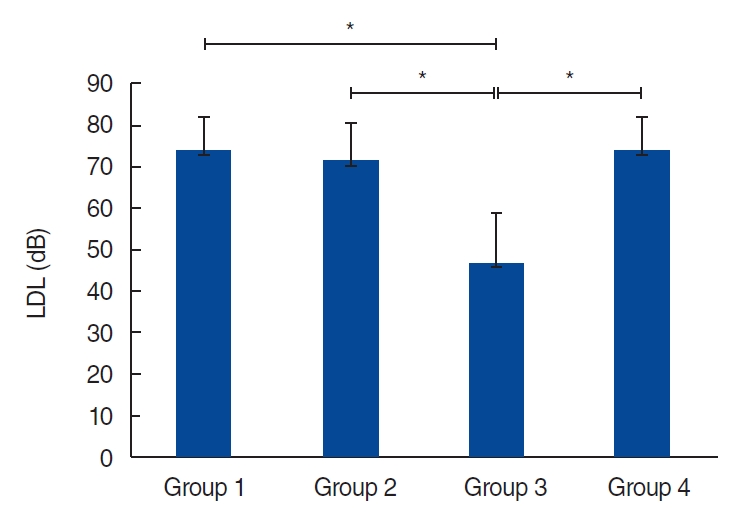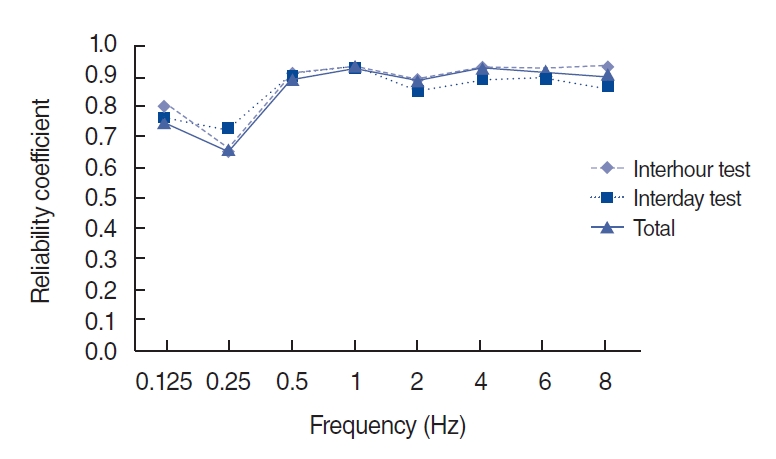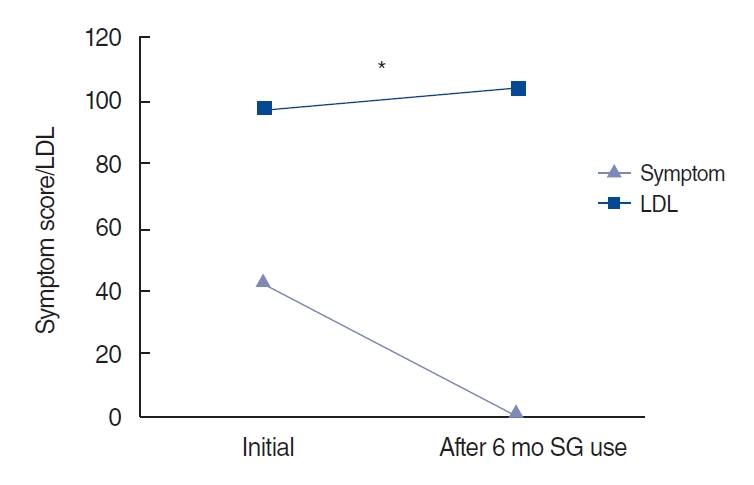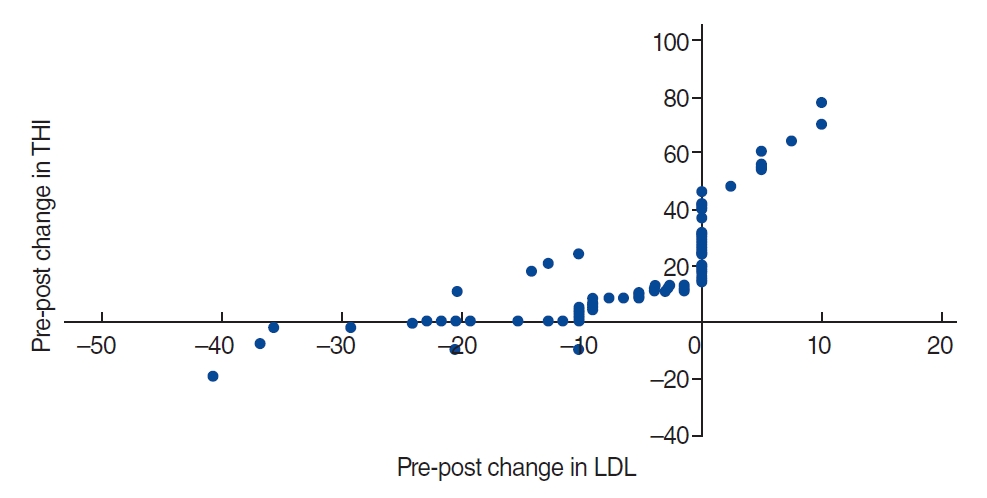Clin Exp Otorhinolaryngol.
2022 Feb;15(1):84-90. 10.21053/ceo.2021.00318.
Measurement of Loudness Discomfort Levels as a Test for Hyperacusis: Test-Retest Reliability and Its Clinical Value
- Affiliations
-
- 1Department of Otorhinolaryngology-Head and Neck Surgery, Seoul St. Mary’s Hospital, College of Medicine, The Catholic University of Korea, Seoul, Korea
- 2Department of Otorhinolaryngology-Head and Neck Surgery, Dr. Paulino J. Garcia Memorial Research and Medical Center, Nueva Ecija, Philippines
- 3Department of Otorhinolaryngology-Head and Neck Surgery, St. Luke’s Medical Center, Quezon City, Philippines
- KMID: 2527116
- DOI: http://doi.org/10.21053/ceo.2021.00318
Abstract
Objectives
. The aims of this study were to investigate the test-retest reliability of measurements of loudness discomfort levels (LDLs), to suggest cut-off values for diagnosing patients with hyperacusis, and to evaluate the clinical value of-LDL measurements as a test for monitoring hyperacusis.
Methods
. For the test-retest reliability of LDL measurements (study 1), a total of 68 patients who sought consultations at our clinic were subcategorized into four groups: patients with tinnitus (group 1), tinnitus and hearing loss (group 2), hyperacusis (group 3), and normal controls (group 4). Inter-hour and inter-day test-retest reliability values using different stimuli were investigated. For study 2, the clinical value of LDL measurements using pure tone stimuli was analyzed by comparing changes after sound generator use in patients with hyperacusis.
Results
. In study 1, the group 3 patients showed significantly lower LDLs than the other groups. High test-retest reliability of LDL tests was demonstrated, regardless of the type of stimulus used. The cut-off values for screening patients with hyperacusis were 90 dB HL using pure tone stimuli and 62 dB HL using white-band noise stimuli. In study 2, significantly increased LDLs were correlated with improved symptoms and improved scores on tinnitus questionnaires after sound generator use, indicating that LDL measurement is a reliable test for monitoring hyperacusis during an intervention.
Conclusion
. LDL measurement is a reliable diagnostic tool to reflect the condition of hyperacusis, especially during the course of treatment.
Keyword
Figure
Reference
-
1. Fackrell K, Potgieter I, Shekhawat GS, Baguley DM, Sereda M, Hoare DJ. Clinical interventions for hyperacusis in adults: a scoping review to assess the current position and determine priorities for research. Biomed Res Int. 2017; 2017:2723715.
Article2. Aazh H, Moore BC, Lammaing K, Cropley M. Tinnitus and hyperacusis therapy in a UK National Health Service audiology department: patients’ evaluations of the effectiveness of treatments. Int J Audiol. 2016; Sep. 55(9):514–22.
Article3. Baguley DM. Hyperacusis. J R Soc Med. 2003; Dec. 96(12):582–5.
Article4. Yilmaz S, Tas M, Bulut E, Nurcin E. Assessment of reduced tolerance to sound (hyperacusis) in university students. Noise Health. 2017; Mar-Apr. 19(87):73–8.5. Khalfa S, Dubal S, Veuillet E, Perez-Diaz F, Jouvent R, Collet L. Psychometric normalization of a hyperacusis questionnaire. ORL J Otorhinolaryngol Relat Spec. 2002; Nov-Dec. 64(6):436–42.
Article6. Greenberg B, Carlos M. Psychometric properties and factor structure of a new scale to measure hyperacusis: introducing the inventory of hyperacusis symptoms. Ear Hear. 2018; Sep/Oct. 39(5):1025–34.
Article7. Sherlock LP, Formby C. Estimates of loudness, loudness discomfort, and the auditory dynamic range: normative estimates, comparison of procedures, and test-retest reliability. J Am Acad Audiol. 2005; Feb. 16(2):85–100.
Article8. Goldstein B, Shulman A. Tinnitus: hyperacusis and the loudness discomfort level test- a preliminary report. Int Tinnitus J. 1996; 2:83–9.9. Anari M, Axelsson A, Eliasson A, Magnusson L. Hypersensitivity to sound: questionnaire data, audiometry and classification. Scand Audiol. 1999; 28(4):219–30.
Article10. Baguley DM, Hoare DJ. Hyperacusis: major research questions. HNO. 2018; May. 66(5):358–63.
Article11. Pienkowski M. Rationale and efficacy of sound therapies for tinnitus and hyperacusis. Neuroscience. 2019; May. 407:120–34.
Article12. Park JM, Kim WJ, Ha JB, Han JJ, Park SY, Park SN. Effect of sound generator on tinnitus and hyperacusis. Acta Otolaryngol. 2018; Feb. 138(2):135–9.
Article13. Sheppard A, Stocking C, Ralli M, Salvi R. A review of auditory gain, low-level noise and sound therapy for tinnitus and hyperacusis. Int J Audiol. 2020; Jan. 59(1):5–15.
Article14. Aazh H, McFerran D, Moore BC. Uncomfortable loudness levels among children and adolescents seeking help for tinnitus and/or hyperacusis. Int J Audiol. 2018; Aug. 57(8):618–23.
Article15. Suhnan AP, Finch PM, Drummond PD. Hyperacusis in chronic pain: neural interactions between the auditory and nociceptive systems. Int J Audiol. 2017; Nov. 56(11):801–9.
Article16. Wallen MB, Hasson D, Theorell T, Canlon B. The correlation between the hyperacusis questionnaire and uncomfortable loudness levels is dependent on emotional exhaustion. Int J Audiol. 2012; Oct. 51(10):722–9.
Article17. Schecklmann M, Landgrebe M, Langguth B; TRI Database Study Group. Phenotypic characteristics of hyperacusis in tinnitus. PLoS One. 2014; Jan. 9(1):e86944.
Article18. Katzenell U, Segal S. Hyperacusis: review and clinical guidelines. Otol Neurotol. 2001; May. 22(3):321–6.
Article19. Meeus OM, Spaepen M, Ridder DD, Heyning PH. Correlation between hyperacusis measurements in daily ENT practice. Int J Audiol. 2010; Jan. 49(1):7–13.
Article20. Sahley TL, Nodar RH. A biochemical model of peripheral tinnitus. Hear Res. 2001; Feb. 152(1-2):43–54.
Article21. Auerbach BD, Radziwon K, Salvi R. Testing the central gain model: loudness growth correlates with central auditory gain enhancement in a rodent model of hyperacusis. Neuroscience. 2019; May. 407:93–107.
Article22. Sheldrake J, Diehl PU, Schaette R. Audiometric characteristics of hyperacusis patients. Front Neurol. 2015; May. 6:105.
Article23. Jastreboff PJ, Gray WC, Gold SL. Neurophysiological approach to tinnitus patients. Am J Otol. 1996; Mar. 17(2):236–40.24. Aazh H, Moore BC. Factors related to uncomfortable loudness levels for patients seen in a tinnitus and hyperacusis clinic. Int J Audiol. 2017; Oct. 56(10):793–800.
Article25. Zaugg TL, Thielman EJ, Griest S, Henry JA. Subjective reports of trouble tolerating sound in daily life versus loudness discomfort levels. Am J Audiol. 2016; Dec. 25(4):359–63.
Article26. Blaesing L, Kroener-Herwig B. Self-reported and behavioral sound avoidance in tinnitus and hyperacusis subjects, and association with anxiety ratings. Int J Audiol. 2012; Aug. 51(8):611–7.
Article
- Full Text Links
- Actions
-
Cited
- CITED
-
- Close
- Share
- Similar articles
-
- The Analysis of Loudness Discomfort Level and Hyperacusis in Tinnitus Patients
- Hyperacusis in Patients with Tinnitus-Audiometrical Evaluation & Clinical Characterization
- The Development of PC-based Mini-Mental Status Examination
- Comparisons of Test-Retest Reliability of Strength Measurement of Gluteus Medius Strength between Break and Make Test in Subjects with Pelvic Drop
- Clinical Findings That Differentiate Co-Occurrence of Hyperacusis and Tinnitus from Tinnitus Alone






